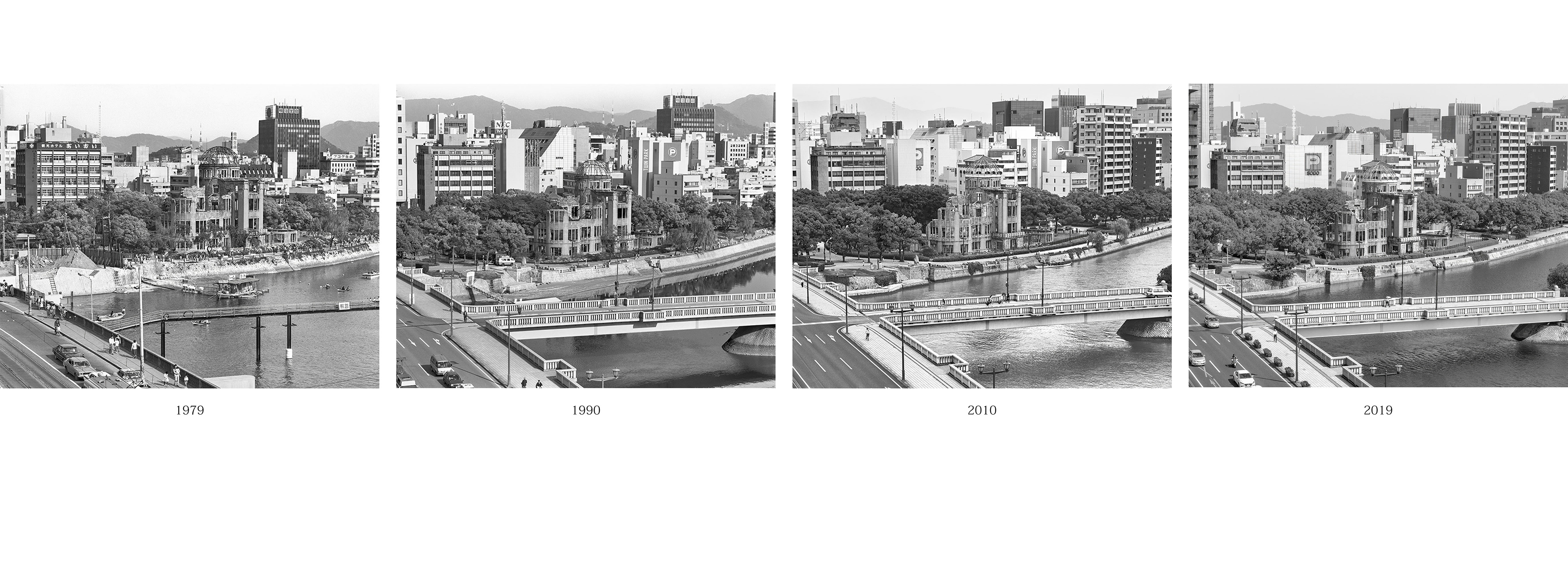土田ヒロミ写真展 Hiroshima Monument-48景/46年
Hiromi Tsuchida Photograpy Exhibition
2025.7.1(火)~7.27(日)開廊:12:00~19:00(最終日17:00まで)

第二次世界大戦末期1945年8月6日、広島市に原子爆弾が高度9600mから投下され、43秒後、市内中心部の上空580m地点で炸裂した。市内全戸のうち62.9%が全壊全焼、被害を免れた家屋は10%にも満たない惨状が現出。原爆被害によって死亡した人々の数は同年11月までに14万人にも達した。
壊滅的破壊にもかかわらず、それをくぐり抜け戦後永く生き続けてきた事物ーー建物、橋、樹木、石碑などーーが市井の片隅に点在している。それらを「ヒロシマ・モニュメント」と名付け、敗戦30数年後の1979年に最初の撮影をした。
さらに同じ対象を、定点観測の手法でおよそ10年毎に撮影した。約10年という時間経過の中で、それらの事物がどのように変化したのか、もしくは、させられたのか、また、それらを取り巻く風景がどのように変化しているかを確認するためであった。この作業を通じて〈ヒロシマ〉の変容の質を写し撮ることができるのではないかと考えたのである。
1979年から2025年まで、約45年間の時間の中で変化する「ヒロシマ・モニュメント」の撮影を継続してきた。被爆80年の節目である今年、これまでの4回にわたる記録をまとめた写真集(ふげん社刊)を出版した。展覧会としての発表はこれが最初となる。
On August 6, 1945, near the end of World War II, an atomic bomb was dropped on Hiroshima from an altitude of 9,600 meters. It exploded 43 seconds later, 580 meters above the center of the city, and caused devastating destruction. Tens of thousands died immediately in the blast. 62.9 percent of all homes were destroyed or burned, with less than 10 percent remaining intact. By November, the death toll had reached 140,000.
A number of objects miraculously survived the blast and remained scattered throughout the city—buildings, bridges, trees, statues. In 1979, more than thirty years later, I photographed these sites under the title Hiroshima Monument.
Since then, I have continued to photograph them from the same perspective and distance approximately every ten years. I did this to observe how the objects had changed—or had been changed—and to document the shifts in their surroundings. I also believed it might be possible to reveal the transformation of Hiroshima’s history through this process.
I have now documented the changing Hiroshima Monument over a period of more than 45 years, from 1979 to 2025. In commemoration of the 80th year since the atomic bombing, the photography book Hiroshima Monument (Fugensha, 2025), which brings together all four photographic records made during this time, has been published. This series of works has been showcased in an exhibition for the first time.
《ダウンロード/Download》
《略歴》
土田 ヒロミ (つちだ ひろみ)
1939年福井県南条郡堺村(現・南越前町)生まれ。1963年、福井大学工学部卒業後、ポーラ化粧品本舗に入社。1964年、東京勤務を機に東京綜合写真専門学校研究科で学ぶ。1966年、同校卒業。1971年、独立し写真家の道を選ぶ。同年、「自閉空間」で第8回太陽賞受賞。1976年ごろから開始した「ヒロシマ三部作」は『ヒロシマ1945-1979』(朝日ソノラマ、1979年)、『ヒロシマ・モニュメント』(冬青社、1995年)、『ヒロシマ・コレクション』(NHK出版、1995年)として刊行され、現在に至るまで広島の撮影を続けている。1984年、第40回日本写真協会年度賞、1987年、第3回伊奈信男賞を受賞。2008年、「土田ヒロミのニッポン」(東京都写真美術館)により第27回土門拳賞受賞。1992年から96年まで東京綜合写真専門学校校長を務める。2000年から13年まで大阪芸術大学写真学科教授。主な写真集に『俗神』(オットーズ・ブックス、1976年)、『砂を数える』(冬青社、1990年)、『新・砂を数える』(冬青社、2005年)、『BERLIN』(平凡社、2011年)、『フクシマ』(みすず書房、2018年)、『Aging』(ふげん社、2022年)など。東京都写真美術館、東京国立近代美術館、横浜美術館、ボストン美術館、ニューヨーク近代美術館、サンフランシスコ近代美術館、カーネギー美術館、カナダ国立美術館、テート・モダン、ポンピドゥー・センターなどに作品が収蔵されている。
《Biography》
Hiromi Tsuchida was born in 1939 in the village of Sakai, Nanjo-gun (now Minamiechizen-cho), Fukui Prefecture. After graduating from the Faculty of Engineering at the University of Fukui in 1963, he was employed at Pola Cosmetics. In 1964, after being transferred to Tokyo, he studied in the graduate program at Tokyo College of Photography, graduating in 1966. In 1971, he became independent and embarked on a career as a photographer. That same year, he won the 8th Annual Taiyo Magazine Award for Autistic Space. Around 1976 he began working on his “Hiroshima trilogy,” which was published as Hiroshima 1945–1979 (Asahi Sonorama Publications Inc., 1979), Hiroshima Monument (Toseisha, 1995), and Hiroshima Collection (NHK Publishing, 1995). He continues photographing Hiroshima to this day. Tsuchida received the 40th Annual Award from the Photographic Society of Japan in 1984 and the 3rd Ina Nobuo Award in 1987. In 2008, he won the 27th Domon Ken Award for Hiromi Tsuchida's Japan (Tokyo Photographic Art Museum). He served as the head of the Tokyo College of Photography from 1992 to 1996, and was a professor in the Department of Photography at Osaka University of Arts from 2000 to 2013. His major photo books include ZOKUSHIN (Otto's Books, 1976), Counting Grains of Sand (Toseisha, 1990), New Counting Grains of Sand (Toseisha, 2005), BERLIN (Heibonsha, 2011), Fukushima (Misuzu Shobo, 2018), and Aging (Fugensha, 2022). His works are held in the collections of the Tokyo Photographic Art Museum; the National Museum of Modern Art, Tokyo; the Yokohama Museum of Art; the Museum of Fine Arts, Boston; the Museum of Modern Art, New York; the San Francisco Museum of Modern Art; the Carnegie Museum of Art; the National Gallery of Canada; the Tate Modern; the Centre Pompidou, and others.

